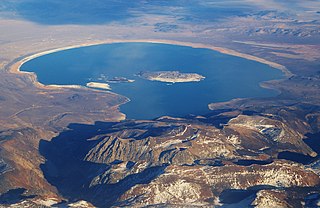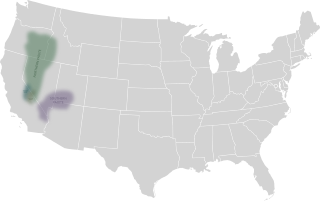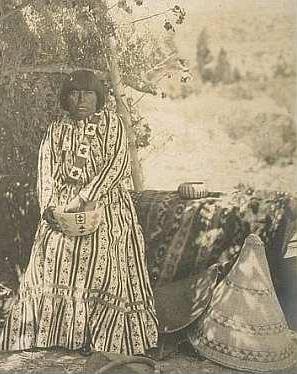External links
| | This article about an ethnic group in Africa is a stub. You can help Wikipedia by expanding it. |
| Total population | |
|---|---|
| approximately 145,000 | |
| Regions with significant populations | |
| Democratic Republic of Congo | |
| Languages | |
| Mono language (Congo) | |
| Religion | |
| Christianity |
The Mono people are a Sub-Saharan people of the Sudanic cluster residing on land adjacent to the northwestern border of the Democratic Republic of Congo.

Mono Lake is a saline soda lake in Mono County, California, formed at least 760,000 years ago as a terminal lake in an endorheic basin. The lack of an outlet causes high levels of salts to accumulate in the lake which make its water alkaline.

Mono County is a county located in the east central portion of the U.S. state of California. As of the 2020 census, the population was 13,195, making it the fourth-least populous county in California. The county seat is Bridgeport. The county is located east of the Sierra Nevada between Yosemite National Park and Nevada. The only incorporated town in the county is Mammoth Lakes, which is located at the foot of Mammoth Mountain. Other locations, such as June Lake, are also famous as skiing and fishing resorts. Located in the middle of the county is Mono Lake, a vital habitat for millions of migratory and nesting birds. The lake is located in a wild natural setting, with pinnacles of tufa arising out of the salty and alkaline lake. Also located in Mono County is Bodie, the official state gold rush ghost town, which is now a California State Historic Park.
Mono may refer to:

Paiute refers to three non-contiguous groups of indigenous peoples of the Great Basin. Although their languages are related within the Numic group of Uto-Aztecan languages, these three languages do not form a single subgroup and they are no more closely related to each than they are to the Central Numic languages which are spoken between them. The term "Paiute" does not refer to a single, unique, unified group of Great Basin tribes, but is a historical label comprising:

Monaural or monophonic sound reproduction is sound intended to be heard as if it were emanating from one position. This contrasts with stereophonic sound or stereo, which uses two separate audio channels to reproduce sound from two microphones on the right and left side, which is reproduced with two separate loudspeakers to give a sense of the direction of sound sources. In mono, only one loudspeaker is necessary, but, when played through multiple loudspeakers or headphones, identical signals are fed to each speaker, resulting in the perception of one-channel sound "imaging" in one sonic space between the speakers. Monaural recordings, like stereo ones, typically use multiple microphones fed into multiple channels on a recording console, but each channel is "panned" to the center. In the final stage, the various center-panned signal paths are usually mixed down to two identical tracks, which, because they are identical, are perceived upon playback as representing a single unified signal at a single place in the soundstage. In some cases, multitrack sources are mixed to a one-track tape, thus becoming one signal. In the mastering stage, particularly in the days of mono records, the one- or two-track mono master tape was then transferred to a one-track lathe used to produce a master disc intended to be used in the pressing of a monophonic record. Today, however, monaural recordings are usually mastered to be played on stereo and multi-track formats, yet retain their center-panned mono soundstage characteristics.

Wagashi is a traditional Japanese confection that is often served with green tea, especially the type made of mochi, anko, and fruit. Wagashi is typically made from plant-based ingredients with an emphasis on seasonality, and generally making use of cooking methods that pre-date Western influence in Japan.
Tenaya was a leader of the Ahwahnechee people in Yosemite Valley, California.

The Mono are a Native American people who traditionally live in the central Sierra Nevada, the Eastern Sierra, the Mono Basin, and adjacent areas of the Great Basin. They are often grouped under the historical label "Paiute" together with the Northern Paiute and Southern Paiute – but these three groups, although related within the Numic group of Uto-Aztecan languages, do not form a single, unique, unified group of Great Basin tribes.
Mono, or Alu, is an Oceanic language of Solomon Islands reported in 1999 to be spoken by 660 people on Treasury Island, 2,270 on Shortland Island, and 14 on Fauro Island.
Mono is a language spoken by about 65,000 people in the northwestern corner of the Democratic Republic of the Congo. It is one of the Banda languages, a subbranch of the Ubangian branch of the Niger–Congo languages. It has five dialects: Bili, Bubanda, Mpaka, Galaba, and Kaga.

Mono is a Native American language of the Numic group of Uto-Aztecan languages, the ancestral language of the Mono people. Mono consists of two dialects, Eastern and Western. The name "Monachi" is commonly used in reference to Western Mono and "Owens Valley Paiute" in reference to Eastern Mono. In 1925, Alfred Kroeber estimated that Mono had 3,000 to 4,000 speakers. As of 1994, only 37 elderly people spoke Mono as their first language. It is classified as critically endangered by UNESCO. It is spoken in the southern Sierra Nevada, the Mono Basin, and the Owens Valley of central-eastern California. Mono is most closely related to Northern Paiute; these two are classified as the Western group of the Numic branch of the Uto-Aztecan language family.
The Big Sandy Rancheria of Mono Indians of California is a ranchería and federally recognized tribe of Western Mono Indians (Monache) located in Fresno County, California, United States. As of the 2010 Census the population was 118. In 1909, the Bureau of Indian Affairs (BIA) bought 280 acres of land for the Big Sandy Band of Western Mono Indians.

The Cold Springs Rancheria of Mono Indians of California is a federally recognized tribe of Mono Native Americans. Cold Springs Rancheria is the tribe's reservation, which is located in Fresno County, California. As of the 2010 Census the population was 184.
The North Fork Rancheria of Mono Indians of California is a federally recognized tribe of Mono Native Americans. North Fork Rancheria is the name of the tribe's reservation, which is located in Madera County, California. Nium is their self-designation.
The Paiute-Shoshone Indians of the Lone Pine Community of the Lone Pine Reservation is a federally recognized tribe of Mono and Timbisha Native American Indians near Lone Pine in Inyo County, California. They are related to the Owens Valley Paiute.

The Kucadɨkadɨ are a band of Eastern Mono Northern Paiute people who live near Mono Lake in Mono County, California. They are the southernmost band of Northern Paiute.

The Original Mono Recordings is a box set compilation album of recordings by Bob Dylan, released in October 2010 on Legacy Recordings, catalogue 88697761042. It consists of Dylan's first eight studio albums in mono on nine compact discs, the album Blonde on Blonde being issued on two discs in its original vinyl format. It does not include the singles collection Bob Dylan's Greatest Hits released during the same time span. The set includes a 56-page booklet with photographs, discographical information, and an essay by Greil Marcus. It peaked at No. 152 on the Billboard 200.
Briggs Automotive Company (BAC)Limited is a British car manufacturer that created Mono, a road-legal sports car with only one seat. BAC is based in the city of Liverpool, United Kingdom, Mono cars are exported to 47 countries.

Mono is a free and open-source .NET Framework-compatible software framework. Originally by Ximian, it was later acquired by Novell, and is now being led by Xamarin, a subsidiary of Microsoft and the .NET Foundation. Mono can be run on many software systems.
Mononoke are vengeful spirits (onryō), dead spirits (shiryō), live spirits (ikiryō), or spirits in Japanese classical literature and folk religion that were said to do things like possess individuals and make them suffer, cause disease, or even cause death. It is also a word sometimes used to refer to yōkai or henge.